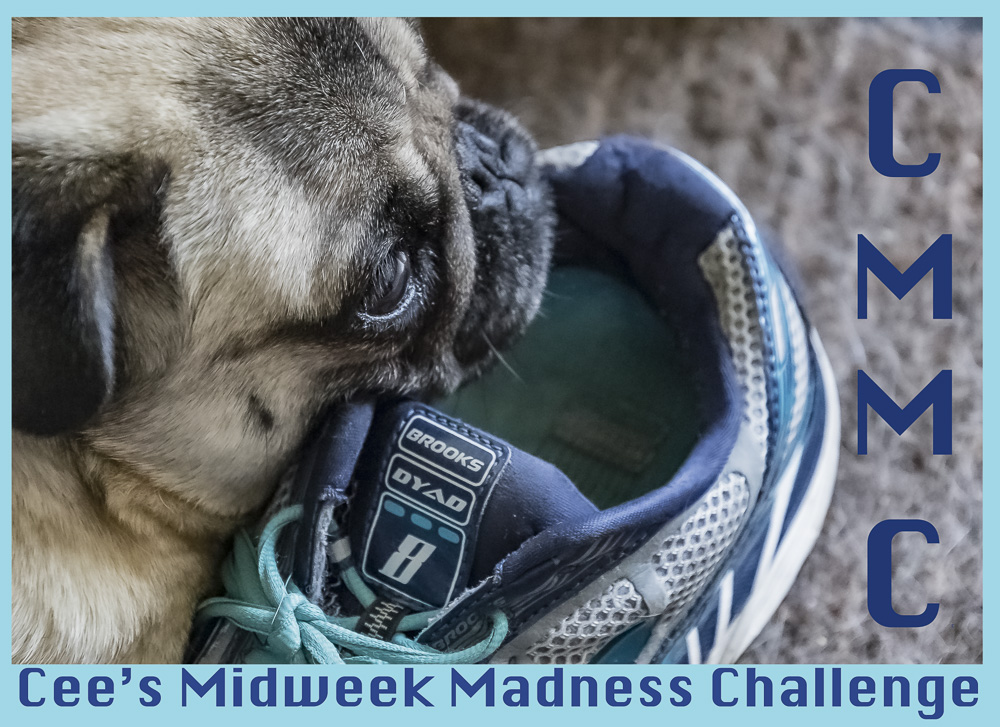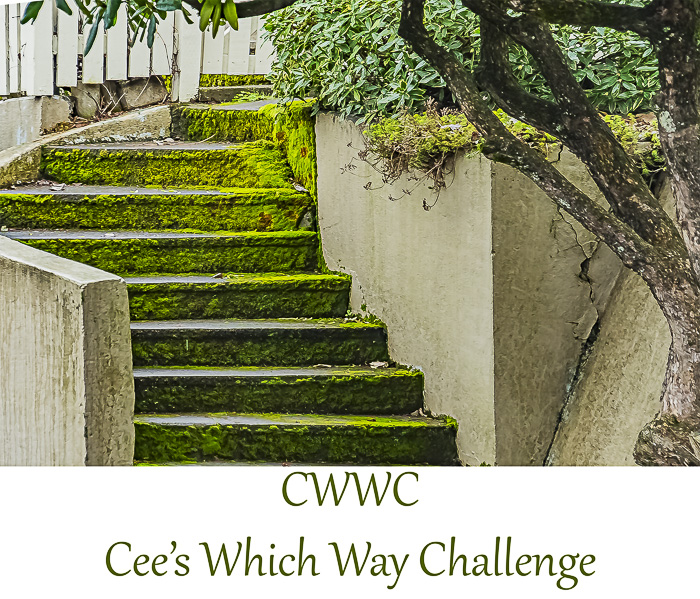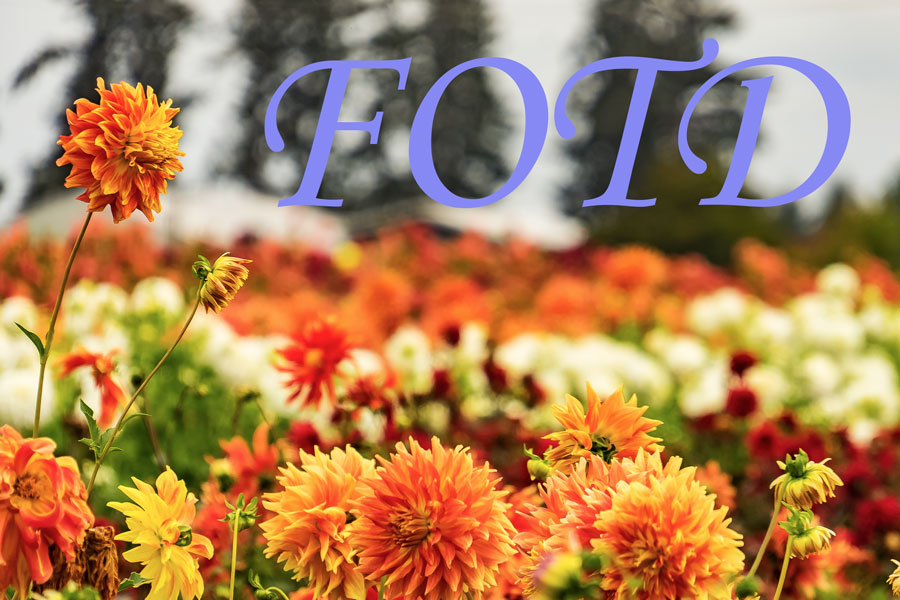Since most of us are stuck inside our homes or yards, I decided to rerun a series I did several years ago, called Cee’s Compose Yourself Lesson (CCYL). This is not a challenge, but I suggest you play with new ideas or ways of looking at taking photos. Hopefully this will fill your day with a little excitement and joy. Please feel free to play along and join in the fun.
Rule of Thirds Introduction
How’s this moon photo I took for a classic example? The moon is on the in the lower 1/3 of the left corner.

Any experienced photographer will tell you that the Rule of Thirds is perhaps the most essential of rules, but they probably can’t tell you WHY it works. The truth is that we don’t know, but it just does. We don’t know enough about the brain and how it works to answer the why of it. Chris and I were watching a television series called Brain Games where they present various optical illusions and explain why and how our brain gets tricked. I think they should do a show on the rule of thirds.
For some reason, an off-center picture is more pleasing to us. It looks more natural. We know from the Brain Game tv show that if we stare at something right in the middle of the screen, our peripheral vision diminishes to the point where it’s not working much at all. Maybe that is what’s happening… we like things off-centered so that we can see more of what’s going on around us.
We also know that the brain fills in negative space, so maybe that’s all part of how we tell stories with pictures. You’ll see what I mean in a moment.
 So let’s divide your view finder into a gird with nine boxes (see grid for landscape photos to the right). The rule of thirds says that you should place the subject of your picture on one of the points where the lines intersect.
So let’s divide your view finder into a gird with nine boxes (see grid for landscape photos to the right). The rule of thirds says that you should place the subject of your picture on one of the points where the lines intersect.
Let’s try out the Rule of Thirds with one of my favorite water lily shots. Putting the flower in the lower left works well.

Here’s another with the subject, my dog Shadow, in the upper right. See how dramatic her placement can be?

The Rule of Thirds also refers to using the columns and rows in your pictures. You can use the bottom third to anchor your subject and create a sense of perspective using the negative space above it, like in this picture I took at the Wooden Shoe Tulip Farm.

Here is an example of using the leading vertical third to create drama and tension. I could crop this to put the man in the center of the shot but then you’d just see some guy sitting on a log. But by leaving two-thirds of the picture as negative space, you start to fill in the end of his story. Did his lover just tell him it is over? Did he just lose his job? Is he pondering some momentous life decision?

This little girl is having a much better day at the beach. She looks like she’s having fun, racing off to see something else. She’s in the right third, with the negative space on the left because she’s moving left. We instinctively look to the left to see where she’s going. If I had shot it with her on the left, we wouldn’t have nearly as much interest in her because she would be almost out of the shot and gone from sight.

Let’s do one more beach photo before we move on. Here’s one that bends the Rule of Thirds until it’s almost broken. The shot is divided almost equally into three horizontal bands. There is negative space in the middle, and more in the sand in the bottom third. The subject of the photo is in the lower left. This picture is off balance with the heaviness of the ocean in the top band.

Enough of the beach. Here’s a simple one that keeps the subject in the lower third.

And another using the lower third to anchor the shot. I love the zen feeling of the gently swirling ripples above the stone.

One more showing the left third.

And here’s one to break the Rule of Thirds by combining the rule in two variations. You can use the rule by showing your subject in one third of the picture with two-thirds being negative space, or you can put your subject in two-thirds of the shot with one-third negative space, but that’s something we’ll talk about next time.

These doors are oddly appealing. I’ve captured my subject in the left two-thirds, so I’m expecting negative space in the right third to balance out the picture. My eye sees the empty wall and is reassured it knows what’s coming next, but then it sees the right third filled up with a more solid, heavier block of color. That unexpected transition automatically forces my eye back to the left so my brain can double check its calculations. It’s a paradox for your brain. If I had the time, I’d photoshop two more pictures, replacing the blank wall on the different thirds to show you how differently the pictures would look.
- CCYL 1: How Your Camera is Not Like Your Eye
- CCYL 2: What all well-composed photos have in common
- CCYL 3: Always Take More than One Photo
- CCYL 4: Simplicity
- CCYL 5: Leading Lines
- CCYL 6: Horizontal Lines
- CCYL 7: Vertical Lines
- CCYL 8: Diagonal Lines
 I’ve gathered a list of challenges and their hosts. So if you know a challenge host, please direct them to my blog. Feel free to contact me anytime. I hope everyone will be able to use my lists.
I’ve gathered a list of challenges and their hosts. So if you know a challenge host, please direct them to my blog. Feel free to contact me anytime. I hope everyone will be able to use my lists.
Qi (energy) hugs
Cee








Absolutely loving your composition series, Cee 👏 they are perfect for an amateur like me 😃
LikeLike
That’s who I want to reach and using common terms and techniques that are easily to understand.
LikeLike
The man on the beach sitting on the rock is such a powerful and sad photo.
LikeLike
He does look sad especially with the shadow. His girlfriend/wife and dog came shortly afterwards. He was just waiting for them 😀
LikeLiked by 1 person
Ahh. He was just lonely then.
LikeLike
Yep. 😀
LikeLiked by 1 person
great shots for rule of thirds Cee
LikeLike
So glad you like my photos for the rule of thirds 😀 😀
LikeLike
A fascinating post – like you say, we often use rule of thirds without realising why it works. Great examples too 🙂
LikeLike
Thanks so much for commenting Peggy 😀
LikeLiked by 1 person
So strange how this works. I enjoyed this post 🙂
LikeLike
I’m so happy you liked this post 😀
LikeLiked by 1 person
Lovely shots. It works so do all your photos.
LikeLike
Thanks Indira for commenting 😀
LikeLiked by 1 person
My pleasure, Dear.
LikeLike
Thank you Cee!
LikeLike
My pleasure Anne 😀
LikeLiked by 1 person
I like this rule of third.. it looks familiar, I think I did shots like this without really thinking, but only liking the effect. Now I know what to call that! Thank you. 🙂
LikeLike
You are right, most of us photographers automatically see in the rule of thirds. Dead center is boring, although there are times for that as well 😀
LikeLiked by 1 person
😀 🌸
LikeLike
Excellent. The rule of thirds is – you’re right – possibly one the most important rules. And you document it perfectly. Thank you.
(Stay safe) 🙏🏻😷
LikeLike
Thanks so much for your wonderful comment,. You stay safe as well. I’m perfectly healthy and safe.
LikeLiked by 1 person
👍🏻
LikeLike